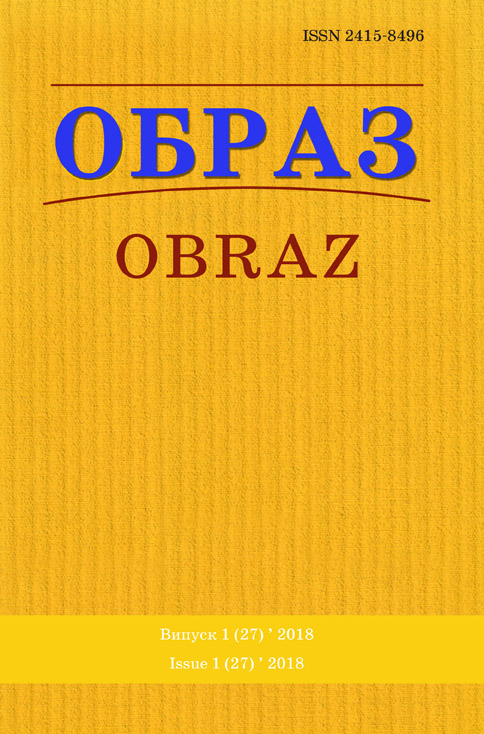Abstract
Introduction. Modern studies of the blogosphere has offered no solutions to the issue of the possibility of replacing blogs with traditional media so far; of journalists’ attitude towards the blogosphere as a competent information source; of the possibility of using blogs for disseminating information to the public.
Aim. To study: the coexistence of modern traditional media and electronic diaries; the indicators of users’ credibility of blogs as a genre of online journalism, as well as journalists’ attitude towards the blogosphere as a competent information source. Practicing journalists’ and bloggers’ electronic diaries dated 2016-2017 have been used as research material.
The factor of a diffusion area between traditional media and blogs as the only components of the modern information field is currently a relevant topic in scientific research.
Method. Review of scientific sources and opinions has become the primary method for identifying the elements of the holistic vision of the blogosphere in the academic community. Generalization has served to create the image of blog perception in Ukraine and worldwide. Web surveying has made it possible to obtain information related to web users’ attitude to blogs as an information source.
Results. The coexistence of blogs and mass media in the electronic media is going through the stage of formation. This process is complicated by the ways the information is presented to the masses. The immense advantage of a blog is the author’s proximity to the target audience. A blog can give a general overview of the public opinion or to determine the response to a particular publication, as well as obtain citation material. A blog is presently the only genre of online journalism capable of performing the function of «social control» that lies in monitoring mass media activity and users’ attitude to it. The diffusion area of traditional media and the blogosphere are characterized.
Conclusions. Bloggers shape a fundamentally new approach to the existence of the communication process. At the same time blogs cannot be treated as professional media, since content quality and author’s competence are the key factor. The volume of material, form of presentation, frequency of information sharing, as well as journalism standards and ethics, are of great importance.
References
1. Berk, D. Web blogs originate in the media: http://www.old.frip.ru/ newfrip/cnt/analitic/ sel/?cid=434&ag=11 (access January 29, 2018).
2. The global policy blogosphere, Information Communication Center: http://www. commcenter.ru/mmedia/articles/2007_07_12 (access January 18, 2018).
3. Vyhovska, N. (2012), «Use of blogs in the structure of traditional media (for example, regional media)», Mahisterium. Zhurnalistyka, vol. 49, pp. 60–65.
4. Kachkaeva, A. H. (2010), Zhurnalistika i konvergentsiya : pochemu i kak traditsionnyie SMI prevraschayutsya v multimediynyieTekst dlya perekladu [Journalism and convergence: why and how traditional media are transformed into multimedia], Fokus-Media, Moskva, Rossiya.
5. Kalmyikov, A. and Kohanova, L. (2005), Internet journalism, YuNITI-DANA, Moskva, Rossiya: http://www.evartist.narod.ru/text16/022 (access January 29, 2018).
6. Karpenko, V. O. (2002), Zhurnalistyka: osnovy profesionalnoi komunikatsii [Journalism: the basics of professional communication], Nora-print, Kyiv, Ukraina.
7. Kihtan, V. V. (2004), Informatsionnyie tehnologii v zhurnalistike [Information technologies in journalism], Feniks, Rostov n/D, Rossiya.
8. Kreig, R. (2007), Internet-zhurnalistyka. Robota zhurnalista i redaktora v novykh ZMI [Internet journalism. Work of journalist and editor in new media], Translated by Ishchenka, A., Kyiv, Ukraina.
9. Pasichnyk, N. (2011), «Artyom Zakharchenko: Future - via the Internet as a communication channel and Internet media as a universal interactive media», Nova Ukraina: http:// novaukraina. org/news/urn:mediacontent:10F0C2B (access January 19, 2018).
10. Panyushina, M. (2009), «Blogs as the main alternative to the media in the 21st century», Nauchno-issledovatelskiy tsentr kontseptualnogo analiza media-soznaniya MEDIANOMIKA: http:// medianomika.ru/wist/c199995 (access January 19, 2018).
11. Pugovskiy, M. «Max Pugowski about the transformation of blogging», Personalnyi blog Oleksandra Semeniuty: http://fireon.org.ua/blogging/makson-puhovskyj-protransformatsiyubloginhu.html (access January 29, 2018).
12. Yasinskaya, M. (2007), «The influence of the blogosphere on the media development strategy», Internet i interaktivnyie elektronnyie media : issledovaniya, Izd-vo MGU, Moskva, Rossiya.
13. Quinn, Н. and Filak, V. (2005), Convergent Journalism : An Introduction, Elsevier, Burlington.
14. Bowman, S., Willis C. We Media : How Audiences Are Shaping the Future of News and Information: http://www.hypergene.net/ wemedia/weblog.php (access January 12, 2018).
15. Stoun, L. «I know social media», BlogHer.org: http://www.blogher.com (access January 30, 2018).
16. Shirkey, C. The political power of social media: https://journalism.nyu.edu/about-us/ profile/clay-shirky (access January 21, 2018).

This work is licensed under a Creative Commons Attribution 4.0 International License.
